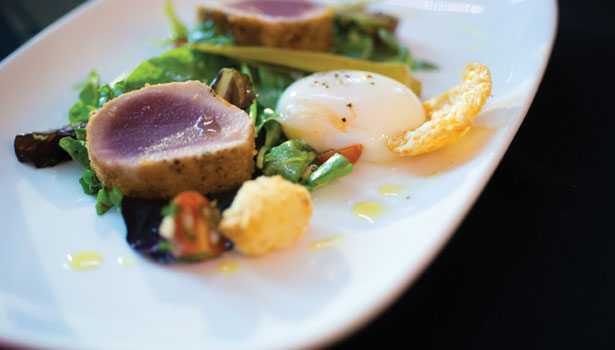Prepared Foods discusses flavorings for seafood with chef David Crews, who won the 10th annual Great American Seafood Cook-Off this August and was named “King of American Seafood.” New Orleans hosted the event, which featured more than a dozen chefs representing states stretching from South Carolina to Alaska; and from Texas to Massachusetts.
Chef Crews is the owner of Crews Culinary Investments Inc. and executive chef at Six Shooter Land and Timber, in Drew, Miss. He and a Mississippi cooking team created a Southern Nicoise Salad with potato-crusted lump crab, as well as tuna loin crusted with pork rinds, heirloom cherry tomatoes, puffed pork skins, Tabasco-cured bacon and poached eggs.
PF: Congratulations on your competition win! How did you pick that particular dish? What “makes” it, in terms of flavor?
Crews: We started by brainstorming -- bouncing ideas off of one another and finding main components that we liked. Then, we started building a dish from those ideas. But, when it comes down to it, we picked this dish because it was us; it was Mississippi!
What makes this dish is how complex the flavors are, and how simple the dish is. The smoky flavor from the pork rinds and bacon; the freshness of a great piece of tuna; the saltiness of the pickled okra; the crunch of the potato crust, but the softness of the crab; and the velvety smoothness of the egg -- and all are put together in a way that is elegant, but not pretentious
PF: Most kids first discover seafood as a fish stick. How about you?
Crews: I have very fond memories of fish sticks and mac-n-cheese. However, a Thursday staple when I was growing up -- and I would have to say that it was my first true experience with fish -- was farm-raised catfish.
Being from the Mississippi Delta, the “catfish capital of the world,” catfish was about the only fish I was exposed to, until I started working in the restaurant world. Then my eyes were opened to all the bounty that the ocean has to offer.
PF: During the cook-off, you probably saw and/or tasted seafood dishes from chefs in other states and regions nationwide. What did you learn?
Crews: I was most impressed with how everyone tried to use something that set them apart and represented their state. For example, I used pork rinds in my dish, whereas a chef from New Mexico used a flash-frozen, powdered corn garnish. It was a matter of little things like that. At this level of competition, little things set you apart.
PF: What’s different about seasoning a fish or seafood dish -- in comparison to other meat proteins?
Crews: To be honest, I am a salt-and-pepper chef! I pride myself on buying great-quality products, and I try to enhance that quality -- not cover it up. I treat almost all protein the same; I think tuna should taste like tuna, and chicken should taste like chicken. It is more about the quality of the protein then what you put on it.
PF: Fair enough. Even so, menu trends change quickly. How would you describe the way seafood is flavored and paired—compared to, say, five years ago?
Crews: I think the main change is that people are trying to incorporate healthier products now, utilizing fresh fruits and vegetables instead of cream and butter sauces.
PF: If we sent you into the supermarket and asked you to buy a few of your favorite prepared fish or seafood items, what would you buy?
Crews: To be honest, I have a six-year-old son and two-year-old daughter, so it’s not exactly fine dining at the house. I would go straight for the Gorton’s fish sticks, which is what I grew up eating and what they like to eat. Also, my local Kroger will steam shrimp on-site, so that would be another “go-to” for me.
PF: When it comes to further-prepared retail offerings or a frozen product already prepared for a restaurant, what advice would you have for fish and seafood companies?
Crews: I think: “the less prepared, the better.” Maybe I’d recommend something like an en papillote item, where everything is “in the bag” -- you just bake and serve, and it is a complete meal. You could make it a nice, upscale TV dinner. Or, perhaps another dish would utilize sous vide technology -- without the requirement of an immersion circulator (found in restaurant kitchens) -- to make it easy on the at-home consumer.
